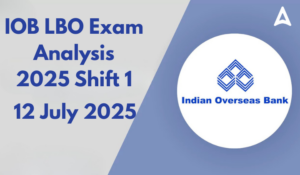History of Banking In India
Banking has been a significant part of our lives for a very long time and this sector contribute a major part in our economy. The history of Banking in India has seen a lot of phases, reforms and has been continuously evolving since then. Aspirants preparing for banking examinations can expect a number of questions from the given topic in the General Awareness section. In this article, we have discussed in detail History of Banking in India.
History of Banking in India: Introduction
As per the Banking Companies Act of 1949, Banking is defined as, A financial institution which accept deposits for the purpose of lending or investment from the public, repayable on demand or otherwise and with drawable by cheque draft, order or otherwise.
What Is a Bank?
As per the regulations of Banking Companies Act of 1949, a bank is termed to be a financial organization that channelizes banking and various financial operations. Their major motive remains to deliver authentic and prompt financial solutions to their customers. A bank is tagged to be an institution that delivers fundamental banking related services like grasping deposits and initiating loans as per the requirements.
भारतीय बैंकिंग इतिहास, देखें बैंकिंग से जुड़े महत्वपूर्ण फैक्टर
Evolution Of Banking In India
Banking has its prevalence in India since Vedic times. But here ,we can categorize the History of Banking in India into 3 stages:
1. Pre-Independence Stage – Before 1947
2. Banking History II Phase – 1947 to 1991
3. Banking History III Phase – 1991 & beyond
Pre-Independence Stage (Before 1947)
The history of banking in India during the Pre-Independence stage has been discussed below highlighting the important points.
• More than 600 banks were present at that phase.
• The first bank of India was established in 1770 thus marking the Banking system in India with the foundation of the Bank of Hindustan.
• Top three banks were merge during this phase – Bank of Bengal, Bank of Bombay & Bank of Madras and came into being as Imperial Bank, which was later taken over by SBI in 1955
• Some other banks were also established during this period like Allahabad Bank 1865, Punjab National Bank 1894, Bank of India 1906, Bank of Baroda 1908, Central Bank of India 1911
Post Independence Stage (From 1947 to 1991)
The major points of the History Of Banking In India from the period of 1947 to 1991 has been mentioned here.
• Nationalization of the Bank took place during this period.
• Central bank of India was also nationalised during this period on 1st January 1949.
• With the recommendation of Narsimha committee, Regional Rural Banks were formed on 2nd October 1975.
History of Banking In India: Beyond 1991
Here, we have mentioned few important points of the history of banking in India beyond 1991.
• Liberalized economic policies were formed to mark the progress of banks in the year 1991.
• This phase was know was the phase of expansion, consolidation, and increment in many ways.
• RBI also gave license to 10 private entities which include – ICICI, Axis Bank, HDFC, DCB, Indusland Bank.
Nationalization & Its Impacts
Nationalization is termed to be the public sector assets transferring to be channelized or owned by the State or Central level Government. Previously in India banks functioning by the private sector were transferred under public sector due to the processing of the Nationalization act. So, the term nationalized banks came into the limelight. Due to the effective measures of nationalization, the banking sector has been benefited with many values and the economic relevance also escalated enormously.
- The masses present in the banks elevated their confidence.
- Banking system became more authorized and eccentric.
- Small scale organizations started growing and their economic growth became legalized with proper monetary values.
- Banking services encircled its presence mostly in the rural areas.
- Goods supply became enormous and stabilization of funding became essential.
- Banking performance also got streamlined and efficient.
Here we are listing out the banks that were nationalized formerly:
| Name of the Banks | |
| Allahabad Bank | UCO Bank |
| Bank of India | Union Bank |
| Central Bank of India | United Bank of India |
| Canara Bank | Bank of Baroda |
| Indian Bank | Bank of Maharashtra |
| Punjab National Bank | Dena Bank |
| Syndicate Bank | Indian Overseas Bank |
Here we are listing out the banks that have reserves more that the amount of Rs. 200 crore and were nationalized on 15 April 1980:
- Corporation Bank
- Andhra Bank
- New Bank of India
- Punjab and Sind Bank
- Oriental Bank of Commerce
- Vijaya Bank
Along with the above listed banks there are 7 subsidiaries of the SBI which were nationalized during 1959.
- State Bank of Hyderabad
- State Bank of Patiala
- State Bank of Mysore
- State Bank of Bikaner and Jaipur
- State Bank of Travancore
- State Bank of Indore
- State Bank of Saurashtra.
These following banks were merged with the SBI later during 2017. The Bank of Saurashtra merged with the SBI during 2008.
History Of Banking In India: Categories
Currently, Banks in India can be categorized into Scheduled and Non-Scheduled Banks:
Scheduled Banks
Scheduled Banks in India are those banks which constitute those banks, which have been included in the Second Schedule of Reserve Bank of India (RBI) Act, 1934. It basically comprises Commercial Banks and Cooperative Banks. Commercial Banks majorly comprises of scheduled and Non-scheduled commercial banks regulated Banking Regulations Act 1949.
Commercial Banks primarily works on a ‘Profit Basis’ and is engaged in the business of accepting deposits for the purpose of advances/loans. We can categorize scheduled commercial banks into four types:
• Public Sector Banks: These are those entities which are owned by Govt. having more than 51% stake in the capital.
• Private Sector Banks: Private Banks are those entities which are owned by private individuals/institutions and these are registered under the Companies Act 1956 as Limited Companies.
• Regional Rural Banks (RRBs): These entities are completely under government and work for the betterment of the rural sector of the society.
Non-Scheduled Banks
Non- Scheduled Banks defined in clause (c) of section 5 of the Banking Regulation Act, 1949 (10 of 1949), which is not a scheduled bank”. Reserve Bank of India is the only central bank of India and all Banks in India are required to follow the guidelines as issued by RBI.
History Of Banking In India: First In Indian Banking System
- First bank in India was Bank of Hindustan (1770)
- First Bank managed by Indians was Oudh Commercial Bank
- First Bank with Indian Capital was Punjab National Bank (Founder of the Bank is Lala Lajpat Rai)
- First Foreign Bank in India is HSBC
- First bank to get ISO certificate is Canara Bank
- First Indian bank outside India is Bank of India
- First Bank to introduce ATM is HSBC (1987, Mumbai)
- First Bank to have a joint-stock public bank (Oldest) is Allahabad Bank
- First Universal bank is ICICI (Industrial Credit and Investment Corporation of India)
- First bank to introduce saving account is Presidency Bank (1833)
- First Bank to Introduce Cheque system is Bengal Bank (1833)
- First bank to give internet banking facility is ICICI
- First bank to sell mutual funds is State Bank of India
- First bank to issue credit cards is Central Bank of India
- First Digital Bank is Digibank
- First Rural Regional Bank (Grameen Bank) is Prathama Bank (sponsored by Syndicate Bank)
- First bank to get ‘in principle’ banking license is IDFC and Bandhan Bank
- First Bank to introduce merchant banking in India is Grind lays bank
- First bank to introduce blockchain technology is ICICI
- First bank to introduce voice biometric is Citi Bank
- First bank to introduce robot in banking service is HDFC
History of Banking in India: Reforms
When all the banks were successfully established in India, it was acquiring thorough regulations and monitoring to make the banking sector highly profitable. Then the following Government enrolled a resolution to draft a committee under the mentorship of Shri M. Narasimha to control the reforms in the banking sector. The following committee has done tremendous regulations to make the banking sector proliferate every time by delivering precise work to the customers. The major step was the establishment of private sector banks. The RBI has initiated licensing ten private sector banks to process for the audience and we have listed those 10 banks in the table below.
| Name of the Banks | |
| Global Trust Bank | ICICI Bank |
| HDFC Bank | Axis Bank |
| Bank of Punjab | IndusInd Bank |
| Centurion Bank | IDBI Bank |
| Times Bank | Development Credit Bank |





 GA Capsule for SBI Clerk Mains 2025, Dow...
GA Capsule for SBI Clerk Mains 2025, Dow...
 The Hindu Review October 2022: Download ...
The Hindu Review October 2022: Download ...
 IOB LBO Exam Analysis 2025, Shift 1 Ques...
IOB LBO Exam Analysis 2025, Shift 1 Ques...


